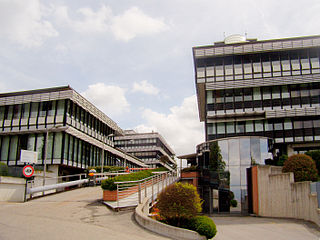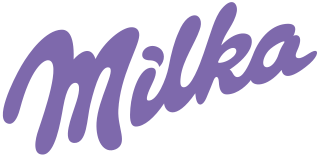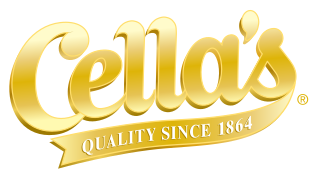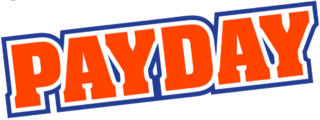
York Peppermint Pattie is an American dark chocolate enrobed peppermint confection introduced in 1940 and currently produced by the Hershey Company.

Ferrero International SpA, more commonly known as Ferrero Group or simply Ferrero, is an Italian multinational company with headquarters in Alba. Ferrero is a manufacturer of branded chocolate and confectionery products, and the second biggest chocolate producer and confectionery company in the world. Ferrero SpA is a private company owned by the Ferrero family and has been described as "one of the world's most secretive firms".

Baby Ruth is an American candy bar made of peanuts, caramel, and milk chocolate-flavored nougat, covered in compound chocolate. Created in 1920, and named after American professional baseball player George Herman "Babe" Ruth, it is distributed by the Ferrara Candy Company, a subsidiary of Ferrero.
Laffy Taffy is an American brand of taffy candies produced by the Ferrara Candy Company, a subsidiary of Ferrero. The candies are small, individually wrapped taffy rectangles available in a variety of colors and fruit flavors, including banana, strawberry, green apple, grape, blueberry, watermelon, blue raspberry, and cherry. Rarer flavors include caramel apple, coconut, strawberries & cream, apple crisp, chocolate mousse, pumpkin donut, pineapple, guava, orange sorbet, and lemon raspberry. Discontinued flavors include fruit punch, mango, strawberry banana, peppermint, and hot cocoa.

Reese's Peanut Butter Cups are an American candy by the Hershey Company consisting of a peanut butter filling encased in chocolate. They were created on November 15, 1928, by H. B. Reese, a former dairy farmer and shipping foreman for Milton S. Hershey. Reese was let go from his job with Hershey when the Round Barn which he managed was shut down for cost-saving measures. He subsequently decided to start his own candy business. Reese's are a top-selling candy brand worldwide, with $3.1 billion in annual sales.
Fanny Farmer was an American candy manufacturer and retailer.

Milka is a Swiss brand of chocolate confectionery. Originally made in Switzerland in 1901 by Suchard, it has been produced in Lörrach, Germany, from 1901. Since 2012 it has been owned by US-based company Mondelez International, when it started following the steps of its predecessor Kraft Foods Inc., which had taken over the brand in 1990. It is sold in bars and a number of novelty shapes for Easter and Christmas. Products with the Milka brand also include chocolate-covered cookies and biscuits.

The Wonka Bar is a fictional chocolate bar, introduced as a key story point in the 1964 novel Charlie and the Chocolate Factory by Roald Dahl. Wonka Bars appear in each film adaptation of the novel: Willy Wonka & the Chocolate Factory (1971); Charlie and the Chocolate Factory (2005); and Wonka (2023). The bar also appeared in Charlie and the Chocolate Factory the Musical (2013).

Oh Henry! was an American candy bar containing peanuts, caramel, and fudge coated in chocolate, sold in the U.S. until 2019. A slightly different version of it is still manufactured and sold in Canada. This version is sold in the U.S. by Hershey, under the name Rally Bars.

Sno-Caps is a brand of candy consisting of small pieces of semi-sweet chocolate candy covered with white nonpareils. Sno-Caps can be found around the world and are commonly associated with movie theaters, where they are often sold at concession stands.

Frango mints are a brand of chocolate truffles first created for the Frederick & Nelson department stores. Traditionally flavored with mint and widely popularized by the Marshall Field and Company department store, they were later produced and distributed by Macy's department stores. Frango is also the brand name of a line of various other related food products.
The Ferrara Candy Company is an American candy manufacturer, based in Chicago, Illinois, and owned by the Ferrero Group.

1-800-Flowers.com, Inc. is a floral and foods gift retailer and distribution company in the United States. The company's focus, except for Mother's Day and Valentine's Day, is on gift baskets. They also use the name 1-800-Baskets.com. Their use of "coyly self-descriptive telephone numbers" is part of founder James McCann's business model.

Cella's is a brand of cherry cordial confection marketed by Chicago-based Tootsie Roll Industries, who purchased the brand in 1985. They were originally introduced in 1864.

PayDay is a brand of a candy bar first introduced in 1932 by the Hollywood Candy Company. The original PayDay candy bar consists of salted peanuts rolled over a nougat-like sweet caramel center. Since 1996, classic PayDay candy bars without chocolate have been continually produced by The Hershey Company. In 2020, Hershey's released a "Chocolatey PayDay bar" as a permanent part of the PayDay product line; it is identical to the regular bar, but covered by a layer of chocolate.

Farley's & Sathers Candy Company was created as an umbrella company to roll up many small companies, brands and products under a common management team. The confectionery business segment is made up of many small companies, often with intertwined relationships and histories.

The National Confectioners Association is an American trade organization that promotes chocolate, candy, gum and mints, and the companies that make these treats. NCA lobbies the American government in favor of the confectionery industry, evaluated at US$35 billion. Confections are produced in all 50 states. The association "annually hosts the National Candy Show in Chicago, as well as the Candy Hall of Fame". As of 2024, the Sweets and Snacks Expo will take place in Indianapolis.

Pearson's Candy Company is an American chocolate and confectionery manufacturer headquartered in Saint Paul, Minnesota. Founded as a confectionery distribution firm in 1909, the company began to manufacture its own products in 1912. Originally a family-owned company, Pearson's experienced changes in ownership, acquisitions and product alterations in the 1960s, 1970s and 1980s, before its most recent sale in November 2018 to Spell Capital, a Minneapolis private equity firm.

Crunch is a chocolate bar made of milk chocolate and crisped rice. It is produced globally by Nestlé with the exception of the United States, where it is produced under license by the Ferrara Candy Company, a subsidiary of Ferrero.
















